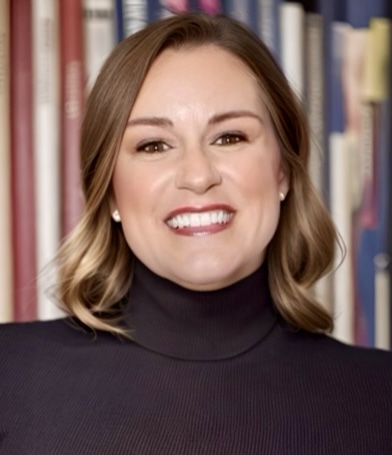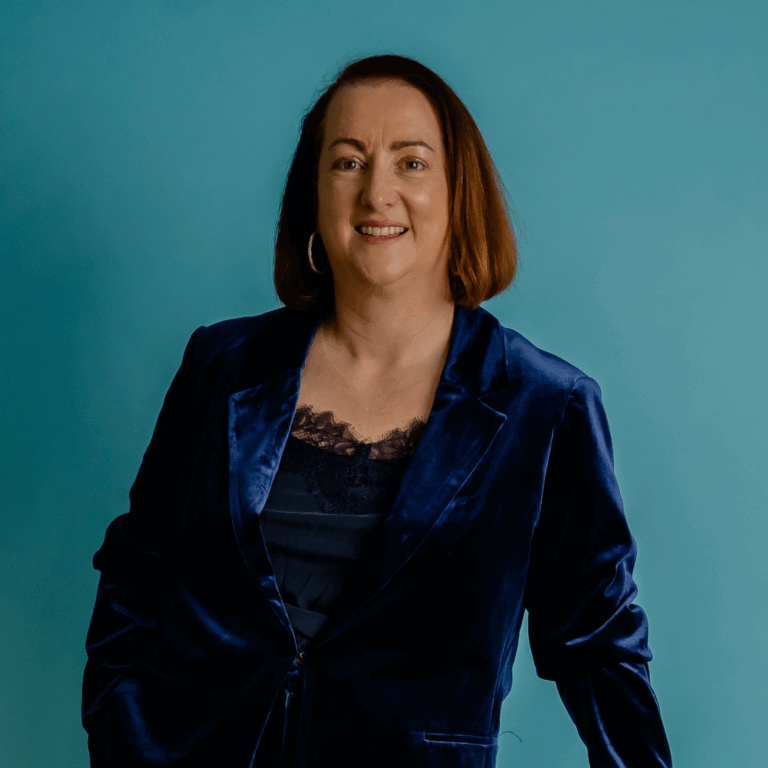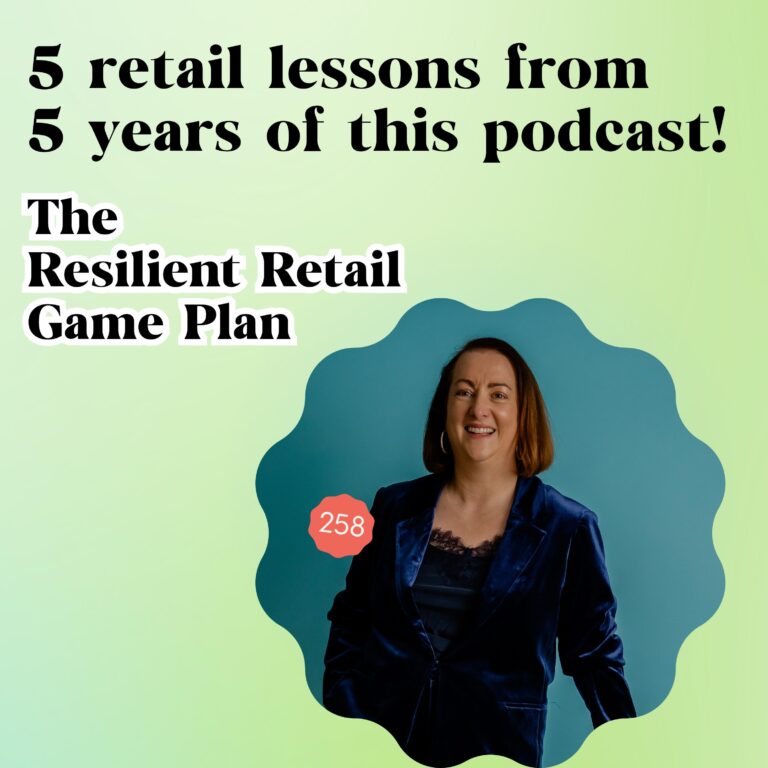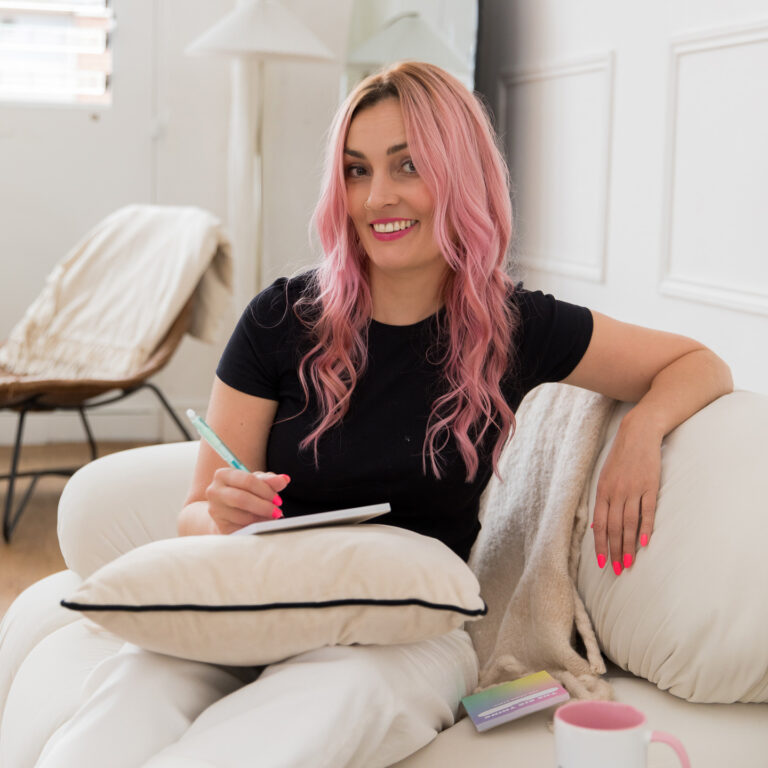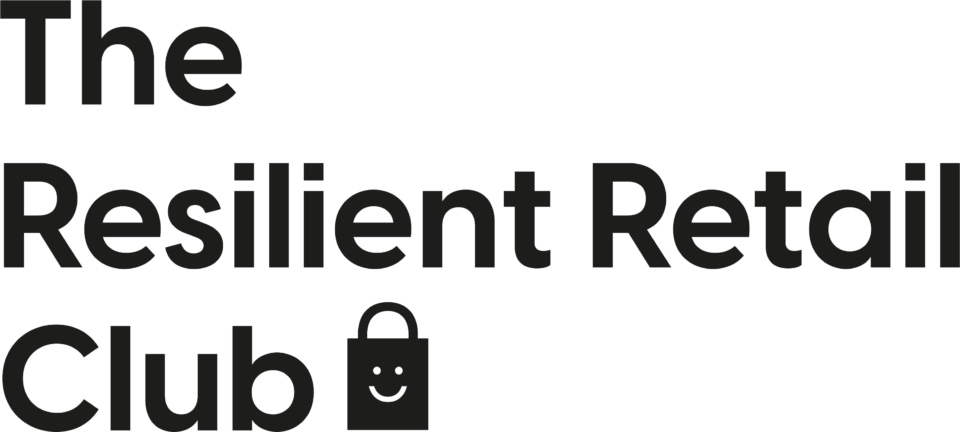Catherine Erdly: Welcome to the Resilient Retail Gameplan. Hi, I’m your host, Catherine Eardley. I wanted to start today with a little bit of a story. So back in 2020, I decided I was going to start a podcast. It was on my list of things to do for 2020. And so I made the decision that I was going to launch one. Because I didn’t know what I was doing, I did a course on how to start a podcast.
It told me all about things like how to come up with a name, how to get create artwork for the podcast, how to choose somewhere to Distribute the podcast all of these different things and one of the sections it had was all about how to edit your podcast Well, I watched this section and the main thing that I took away from that course was that I was never ever going To find the time to edit my own podcast.
So I reached out and to amazing freelance podcast editor, James King, who has been the podcast editor for the last 172 episodes. Now, when I first started working with James, he was a freelance editor and has since been snapped up by a company, which is not surprising because he’s fabulous at what he does.
And as a result, We are now parting ways. This is our final episode that he’s editing and I just wanted to say a huge thank you to James for everything that he’s done over the last more than three years. It’s been an absolute dream to work with. We’ve never actually met in person, which is quite funny when I think about how much we’ve talked over email.
But if you have enjoyed the podcast, whether you listen to one episode or 172, I know some people have listened to them all, then you didn’t know it, but you also can join me in thanking James for all of his hard work.
So on to today’s episode. I am joined by Leanne and Emma, who are a couple who run a business called Rose’s Wardrobe.
I wanted to talk to Leanne and Emma today because they have a fascinating story about how they went from working in fast fashion to creating their own slow fashion business, and also a really fascinating turn their business took where they actually are looking into preserving the heritage of the textile industry in the area in which they work.
It’s a great one for anyone who’s interested in sustainability, building a business with a real purpose at its core.
Welcome to the Resilient Retail Game Plan, a podcast for anyone wanting to start, grow, or scale a profitable, creative product business with me, Catherine Erdely. The Resilient Retail Game Plan is a podcast dedicated to one thing, breaking down the concepts and tools that I’ve gathered from 20 years in the retail industry and showing you how you can use them in your business.
This is the real nuts and bolts of running a successful product business, broken down in an easy accessible way. This is not a podcast about learning how to make your business look good. It’s the tools and techniques that will make you and your business feel good. Confidently plan, launch and manage your products and feel in control of your sales numbers and cash flow to help you build a resilient retail business.
Emma and Leanne, thank you so much for joining me. Do you want to start off by introducing yourself and your business?
Emma and Leanne Duncan: Yep. Hi I’m Emma and this is my wife Leanne. We are the wife and wife team behind Rose’s Wardrobe which is a vintage inspired clothing and accessory brand based in Langham, the south of Scotland. We produce made to order, made to measure garments and accessories for a wide range of customers using local fabrics vintage fabrics and natural fabrics.
Catherine Erdly: Fantastic. So do you want to tell me a little bit about how you guys got started and how the business has evolved over time?
Emma and Leanne Duncan: Yeah, absolutely. It’s been a bit of a journey. We met in Langham. We both have fashion backgrounds. So I did design at uni, Leanne did, what’s your, the name of yours? Clothing designer manufacturer. Yeah. So a bit more technical. Yeah. And we were looking for jobs and I was expecting to go somewhere like Manchester, London, somewhere very fashiony, but ended up in a small town just over the Scottish border, it’s called Langham, and working for a high street brand. And yeah, fell in love with the town. So worked on a range of ladies wear garments, range of collections, and it really taught me a lot about what happens in the fashion industry from that sort of level.
So yeah, my background, my degree was then more technical based, pattern cut and costings market and things like that and ended up in Langham as well. Started off as. A production coordinator and moved on progress to become a trainee production manager.
And that’s when I met Emma. I would bring me the designs and I would usually tell her they were going to be too expensive.
Catherine Erdly: Sounds familiar.
Emma and Leanne Duncan: I would do the cost ends and arrange the deal with it all the way through to shipping. So I would work with the designers, the buyers, the merchandisers. Across that and then ended up moving to Manchester and went into together and went into work with a supplier.
So then I became a, I can’t remember what my job role was. Like a merchandiser for the supplier, so I would work with the customers between the customers and the factories to develop ranges. So yeah, I’ve done a few different jobs,
Catherine Erdly: What was it that really made you decide that you wanted to start your own business?
Emma and Leanne Duncan: Yeah, so it was really in Manchester when we started thinking about starting our own business. But we really looked at starting it too big and too fast. So looking at minimum order quantities at factories and like how much fabric we needed and producing a whole collection of blouses, skirts, dresses, and then the expense that was going to be.
We were also like, led by the company that Emma worked for there was feedback from the customers that they wanted natural fabrics that they wanted better quality. And I was getting to the stage that, you know, keeping on fighting with With factories and costings and just get that extra three pence just wasn’t really sitting very well with me anymore. Like I just was feeling a bit like, there’s somebody else at the end of this. Like If I’m get, if I’m saving three pence on this for the customer, like that’s coming off somewhere else, like it’s not free money.
We’re not saving money. Somebody’s paying for it somewhere down the line. So I think when we were coming home at night and Emma was saying about her. struggles at work, trying to. Get across what the customers wanted and then my struggles at work Just feeling a bit deflated by it all we’re not really feeling like it’s that well with my personal ethos anymore That we thought we will bring the two together. We also at the time that I had just lost my gran who I was really close to, and we were going through family pictures and sort of, oh well, it would be great to recreate these garments, that I’ve looked at, and went, oh I love that jacket, I love this, and but yeah, that’s where, We joined all the, those things together and then called it Rose’s Wardrobe after my gran Rose.
Catherine Erdly: Oh, lovely.
Emma and Leanne Duncan: It has like a personal connection to us as well.
And I’ve always loved vintage fashion been collecting vintage patterns for years, heavily influenced by my nana. She loves a collection and she loves adding to that collection for you, so she’ll go out to, Car boot sales, things like that and pick up patterns and buttons and stuff.
So now, yeah, my Nana’s a really big influence in that as well.
So looking at pictures of her and her mom as well, and her. Her great grand and things like that. So I think if I hadn’t have done like fashion I would have definitely have gone into like historical costume design because that’s something that. So I feel like now with the business, I’ve brought them two things together.
So I am doing what I wanted to do anyway No, but it’s really nice and engaging with people as well about vintage pictures has been really lovely along the way, like people sending in their own pictures of grannies and granddads in their amazing outfits from the 40s, 50s, 60s. So it’s really lovely that we’ve had that sort of engagement.
So it wasn’t until we moved, actually moved back to Langham a couple of years after moving to Manchester that we really thought about the business and how we were going to go forward. And we actually went to a fashion revolution seminar in V& A Dundee in October 2019. And that really made us rethink about the whole process and looking at our skills. ’cause we could both sew, not for a long time, but we still could, like Leanne could make patterns. We could both sew and Yeah. Really looking at our own strengths and how we could bring that to the business rather than trying to go too big with manufacturers and things like that.
Catherine Erdly: So, you decided To start the business, but making it that made to order made to measure.
So you started off with your own patterns then that you designed.
Emma and Leanne Duncan: Yeah. Yeah. And we still use our own patterns that, that we design. Yeah, so we started off with sort of two skirt styles, a blouse style and a dress, and offered them in fabrics that we had picked and sourced, and went from there. then it’s, it’s sort of evolved over time. We still, well, we don’t do that so much now where we used to make collections and then we would put them out there and people would order them.
And through time we’ve realized that, having a good engagement with customers on Instagram and stuff, they’ve come to us and said, Oh, I like that, but it’s not really my colors. So we’ve went out and sourced other fabrics for them and stuff. So yeah, the business is slightly evolved from making collections and us sitting down and picking fabric, sourcing fabrics and, yeah, it’s a lot more customer engagement now. Yeah. People. People fill in a form online and pick from a library of our own fabric. So it’s a lot more free for the customer instead of being in this, the restraint of this skirt comes in this fabric. And yeah, it’s, it is, it’s definitely changed.
Yeah.
Do you
Catherine Erdly: feel that people are really appreciative of the fact that it’s vintage or dead star core? That it’s all natural fibers your customers really looking for them, that sustainability element.
Emma and Leanne Duncan: Yeah. Yeah. We do have the occasional customer who might say, Oh, can I use a polyester lining? But we just don’t. So we just we have to just work and those constraints of what line is we can get within sort of their price bracket and stuff. Because. We just, yeah, we like to keep everything as natural as possible.
We have our fusibles are all cotton fusibles threads are tensile we still have some polyester because we’re phasing them out,
so it’ll take a long time, but yeah, just so
that basically, hopefully it’s a long time and people can pass our clothes down, like vintage clothes are passed down at the moment, but if they do.
End up that they are at the end of their lifespan that somebody could cut them up and put them and their compost bin
That they would. Yeah.
Catherine Erdly: And so how important do you think it is to the customer then that they’ve got that personal relationship with you and that your ethics and values as you like align with theirs?
Emma and Leanne Duncan: Yes, it’s really important with people. We do still have online a size chart to try and like put a number around different sizes, but actually the vast majority of our customers just send their own measurements. And I think it’s really important to get across that you don’t have to fit in that size 16, 18, and it has to be your bust and your waist and your hips have to be in that category.
There’s so many different body types and having clothes that don’t fit isn’t down to you, it’s down to the way that the clothes are manufactured.
So there was a lady that we did a Zoom with, and she was like, Oh, I don’t know where, I don’t know where my waist is.
And Leanne was on the call because she was in America well, where do you want your waist to be? Like, where do you feel comfortable with your waist, your waistband to be? And she was like, Oh. Can I do that? And we’re like, yeah, cause we’re making it for you. So we’re making the clothes to fit our customers instead of our customers having to fit into our clothes.
Which I think is. is the huge thing. I know myself, I’m not the, I don’t know, I don’t know who is the right body size. I don’t know who, who fits in these size measurements but very few people and I think wearing something that actually fits you is such a confidence boost as well. There’s nothing worse than putting something on and It’s a bit tight there
and we’re actually getting something that fits you and fits your bust, fits your waist, fits your hips, is, is such a confidence boost for our customers. I think that’s why we see such a lot of repeat customers as well because once they’ve made that jump and our clothes aren’t cheap they are expensive.
But we do make them to last and the cost per wear we know that some of our original customers, the cost per wear must be very minimal now because they’ve made that investment, but they’ve been able to wear it with so many different things and really love their clothes instead of buying something, wearing it once or twice and going, Oh, don’t feel comfortable in that, getting rid of that.
No, it’s going to fit you. And you could wear it as. Because, and people will wear it. I know myself, I’ve got favourite things and I wear them all the time.
So it’s,
yeah.
Catherine Erdly: And so if you had to sum up then the difference between the approach that you have now and the approach that you were forced to take when you worked in the fashion industry in the big, big retailers, would you say that’s it in a nutshell that you’re working to the customer rather than expecting the customer to fit with you?
Or do you think it goes beyond that as well?
Emma and Leanne Duncan: I think we have tread our own path on this. YeaH, working for the customer, we’re probably doing a lot of things wrong by that. We’re not salesy, we’re not pushy but we just want people to feel comfortable in it while not stocking up a load of like garments that we’re hoping somebody’s going to come along and buy.
And allowing them that freedom to. Pick whatever they want. Instead of just what’s in trend, what’s on trend at the minute, oh purple’s on trend. You have to wear purple because that’s everywhere.
No, just, pick. And I think, I think you could slowly see it as well with people shopping more in charity shops and vintage and things like that.
maybe trends aren’t going to be such a big thing. In the future, they’ll obviously be there to some degree, but maybe not everybody’s wearing the same color at the moment, or everybody’s wearing the same style, like it might just be people wear what they want to wear. And I think even as well, we’re starting to see customers coming through that aren’t quite the vintage customer that we had at the very start, that they are a bit I don’t know how to… They just want well made clothes. Yeah, they just want well made clothes, yeah, and it’s not necessarily just a vintage look that they’re going for, that they’re just looking for well made clothes. A nice jacket.
A nice jacket, yeah. A nice skirt. Yeah.
Classic style. Yeah, definitely different from the buy them cheap, stack them high. Sorry approach that we had. That’s worlds away now.
What we’ve done before and when I’m costing things and I’m looking at the cost, I’m thinking, Oh my goodness.
Like what I would have paid before or looked at a price and went, Oh, that’s far too high.
I just have to step away. That was a different world. And we will never achieve the quantities and stuff that we’ve done before, but we’re doing something completely different.
Catherine Erdly: And you’re making it for longevity. You’re building it for longevity, right?
Emma and Leanne Duncan: Yeah. Uhhuh. . Yeah. And I don’t think we’ll ever be millionaires from that, but
Catherine Erdly: But you’re creating something that people really love and come back to.
Thank you.
Emma and Leanne Duncan: Yeah. Mm-Hmm. .. And I think as well, like it gives us a boost seeing like the girl that is a full-time employee, as she started with us in 2021, she’s made her first full set of garments for a customer and even seen. Her making them are sending them off.
We always have anxiety when we send off a garment until we hear from the customer. And when she heard back from the customer, they’re like a review of it, which was amazing Just seen the boost on her, the customers really enjoyed this. The customer got the whole experience of Picking the fabrics picking trims Then seeing the process happen and then waiting to get the garments like it’s just it’s more than just Going to a shop and quickly picking something up for where it’s a whole different thing.
And when you’re putting that on well, I’ve helped, helped design this and I’ve chose this line in and. Yeah it’s more than just picking something off a shelf.
Catherine Erdly: Yeah, completely. I love that. So can you tell me a little bit about, you have a community interest company as well, is that correct? Can you tell me a little bit more about, about what that is and why you decided to set it up?
Emma and Leanne Duncan: Yeah in October 2020, we got the opportunity to move into a small space within the last working textile mill in Langham called Drove Weavers, opposite the incredibly talented Darners that were in that room. So we saw the fabric coming off the looms all stacked up ready for the darners to check over the fabric for any imperfections, and we just saw how amazing the textile industry actually was in Langham.
But actually what we also saw was the lack of people engaging with it and coming in like young people engaging with the textile industry. And it was quite a worry at the time that the traditional skills for the weaving process, we’re going to get lost with people retiring and things like that.
Cause the workforce in Drove Weavers is a. Aging workforce. The managers in his seventies Donna’s in their sixties. So we need to rejuvenate it with a fresh cohort of young people coming in and taking interest in the industry that’s in that town. And Langham once was a massive textile fabric creation town.
It had 15 working textile mills in its heyday in the, in the 1900s. we’re down to the last one and we really needed to preserve these skills. So yeah, we, we had a brainstorm help from a lady called Judith, which she was invaluable of her experience and just thought Actually, we need to do something a bit more about this and started the creation mill CIC.
In November 2021 whilst also expanding on Rose’s wardrobe as well. So it has been quite a juggle. Leanne’s picked up more of the Rose’s wardrobe side while you’ve left me running. Yeah. Yeah. I have these great ideas and then wind them up and let her go. Yeah. But it’s.
It’s already come on leaps and bounds I think as well because it is a small town and there’s been so much industry and they’ve seen so much industry leave the town, there is a sort of yeah, a sort of negative vibe around, around the town like, oh, you know, there’s no, future in the textile industry and stuff, but actually the designers that go through drove weavers.
You just wouldn’t believe it. You know,
It’s a little door like, yeah, that you go through and there’s just this buzz of activity as soon as you open it really high end. Yeah we have seen some fabrics that we’ve. Helped fold on the catwalk. And it’s just getting, the kids from a young age interested in these things.
And also, not every child is academic. They want to stay in Langham. They want to just do something like a skill with their hands. They maybe don’t want to be a joiner or an electrician or whatnot. And this gives them something that they can go into and go. Oh, yeah, I am good at this actually and have that, it’s very technical and it’s very all about logic and stuff like that.
But you have got that design element as well. And I think engaging with them young and getting them interested, but we’ve got an after school club. We do summer clubs. We work with local schools. We’ve got people coming in on work placements. enjoyment social sessions from like around wellness and mental health,
Different age groups, not just young people.
We have a a community scrap store, which is donations from the public and industry partners that we resell on just to make an income. Because the community interest company is a social enterprise and it straddles Halfway between a charity and a business.
So we can go for a certain amount of funding to help support our free sessions, like the after school clubs and things. But we also need to have an income. And in the future, the end goal is to be financially sustainable from our own income, rather than being grant reliant. I think that’s a really good model to go for.
The end goal is really to have a sort of training hub for the textiles industry that people can come in either just want a career change or kids from schools or working with the school to Gain qualifications and in textiles . We have a dyers here as well, quite a big dyers. Like going out and working with them, working with the dye house, then seeing it getting woven up going away to get finished, come in to Rose’s wardrobe to learn how to sew things up. And doing the market and the website, things like that. See the whole process that goes into the textile industry.
Cause I think that’s what people don’t realize how, how many different elements that are to it. And these young people with the skills that they have bringing that into a traditional economy. So the website, the marketing TikTok, Social media marketing, like the traditional companies like Drove Weavers haven’t got time for that.
They’re very focused on the skills that they’re doing. So if we can teach these young people a really traditional skill to carry that forward, but also they have the opportunity to market what they’re doing Put items on the website and do social media marketing. That’s that’s a current and future skill that these traditional companies just wouldn’t have had.
They all go by word of mouth recommendations. it wasn’t until a couple of years ago that drove weavers actually had a website like an internet presence because you can find them on Google.
Yeah.
Yeah. So they’ve just solely relied on repeat customers, word of mouth, which has been great, but we need to take that business forward.
They do need the younger people’s skills and social media and websites and things. So yeah, it’s really combining the two skills together.
Catherine Erdly: yeah. And do you feel positive about the future of the, of textiles and traditional industries like this in the UK?
Emma and Leanne Duncan: Absolutely. I’m really excited. I’m in so many working groups with Scottish textiles, like regeneration of textiles and things. My particular interest at the moment is fiber production and local sheep farmers and how we can make that more sustainable. So yeah, I think it’s a really interesting area to be part of at the moment.
I’m really excited I think
Catherine Erdly: UK? Fantastic. Thank you so much for sharing your story with me and sharing the amazing story of Creation Mill as well. It’s really fascinating to see how you’re working with both sides of this here with your fashion realm and also with working to, to promote and prolong the life of these traditional industries and really exciting times.
Do you want to tell us a little bit more about how we can find out more about Roses Wardrobe and Creation Mill?
Emma and Leanne Duncan: Yeah, absolutely. So we’ve got a website www.roseswardrobe.co uk. We are at Roses Wardrobe Vintage on Instagram and also on Facebook and Creation Mill website is www.creationmill.org, and then it’s Croatia Mill. Do lag on Instagram.
Catherine Erdly: Thank you so much for listening. Why not head over to see me on Instagram at Resilient Retail Club. Why not come say hi on tick tock. I’m actually working. I’ve started posting on tick tock again. So if you’re on tick tock, then come over, say hi, give me a follow. And it would be great to hear what you took away from today’s episode.
I love to see where you are, where you’re, when you’re listening to the podcast. It’s always great to see people’s pictures.
And of course, if you have a moment to rate and review the podcast, either rating it inside the Spotify app or rating and reviewing it within Apple Podcasts, that means the absolute world to me in terms of getting the podcast out to more people. And of course, if you like or subscribe, then you will be the first to know

